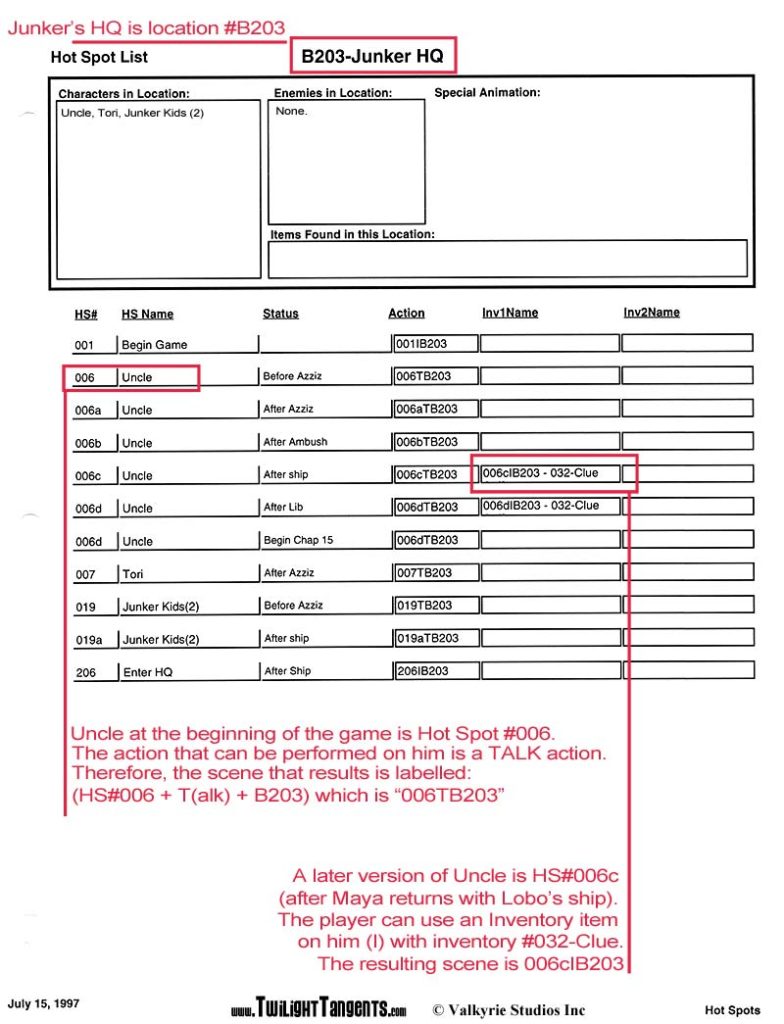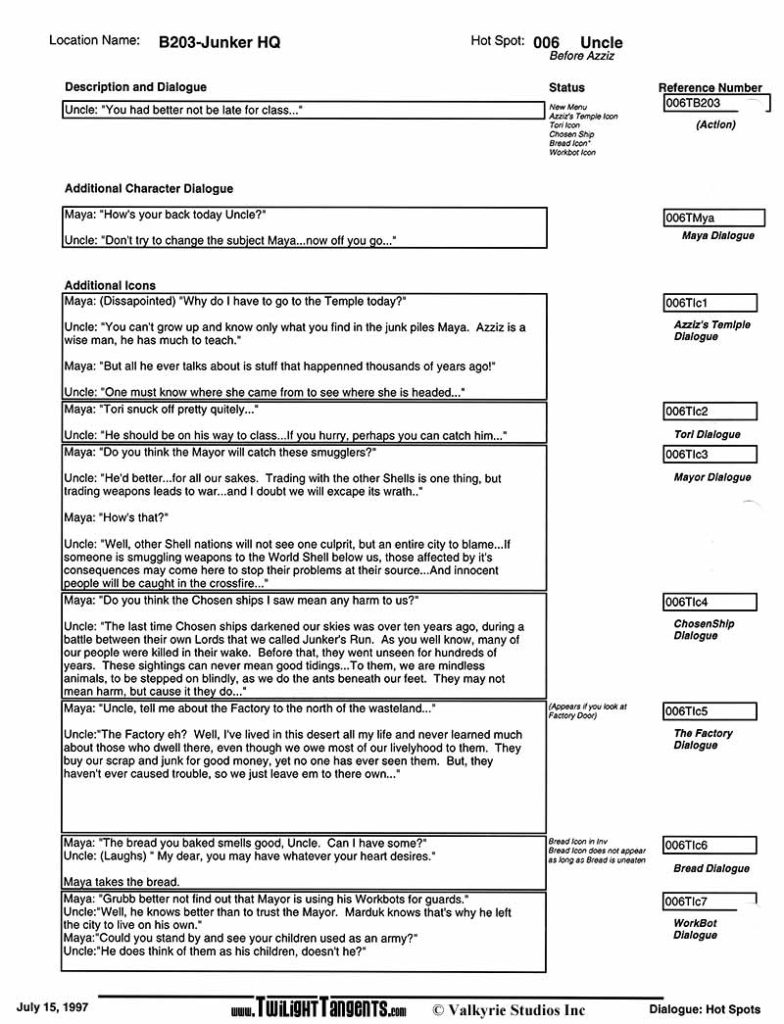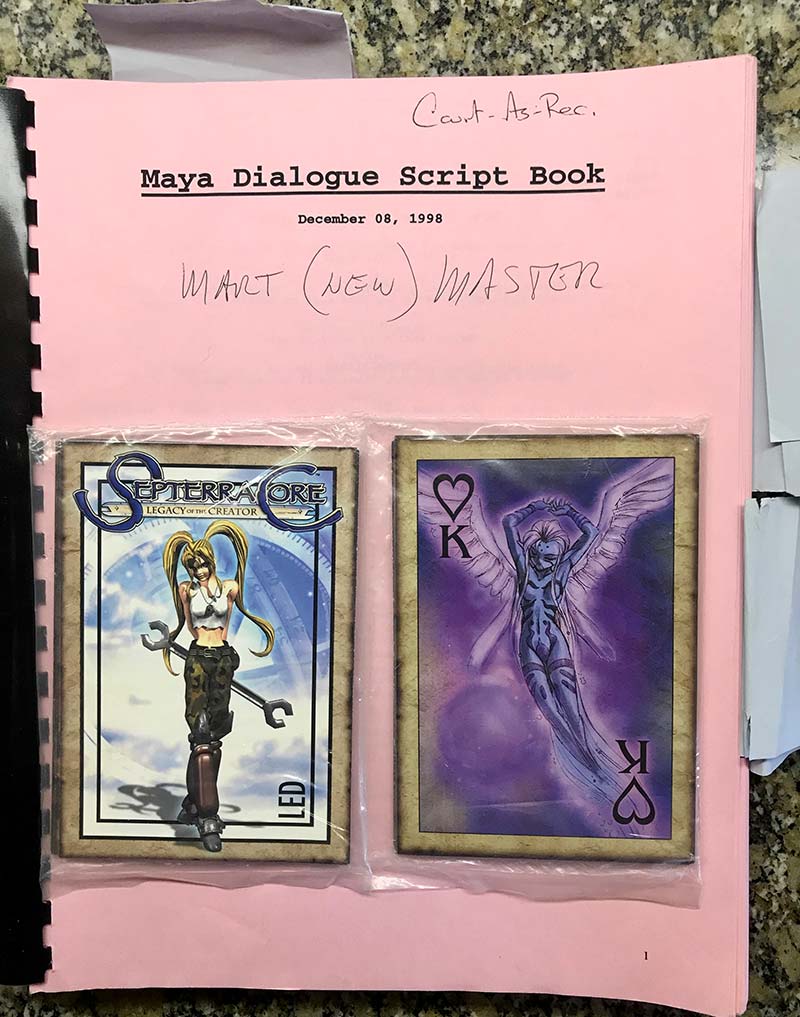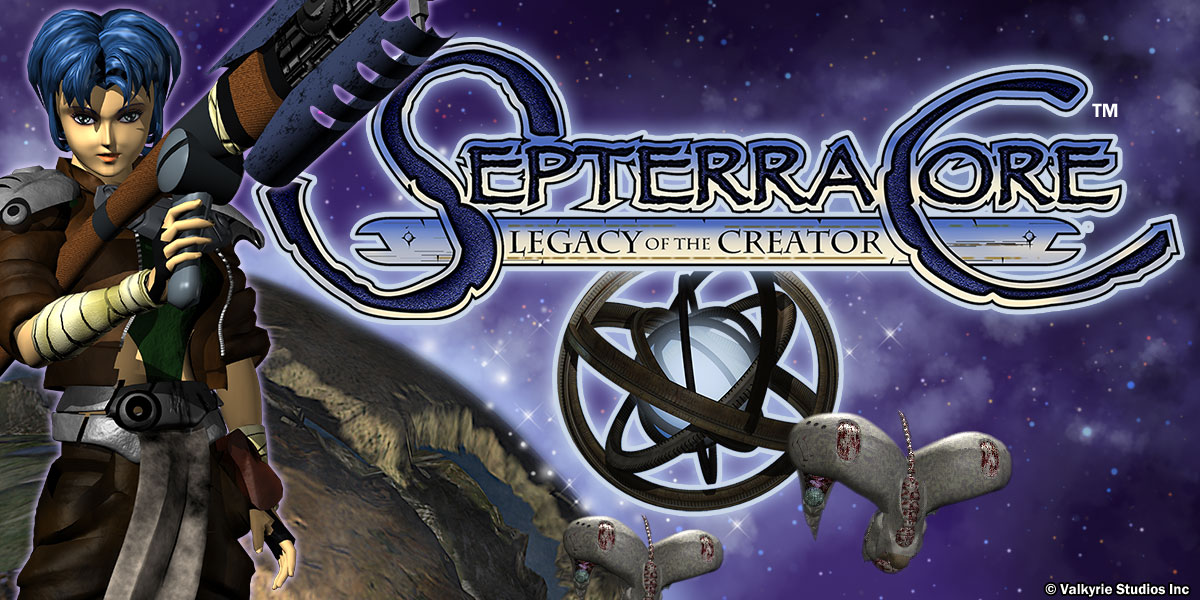Septerra Core: Legacy of the Creator marked its 20th anniversary since publication late in 2019. What follows is part 07 of a deep dive retrospective on the making of this cult classic RPG!
(BTW – In case you missed them, here’s Part 01, Part 02, Part 03, Part 04, Part 05, Part 06, & Part 07)
Septerra Core development was in full swing in late 1998 and through 1999 at Valkyrie Studios. While the team was busy at work creating the assets and building the game, there were aspects of the final production that would need to be outsourced, namely the audio design, including music, sound effects, and recorded dialogue. The script had been finished for some time, but it would be a unique and daunting task to get it integrated into the game.
Putting the script together
Septerra Core’s script was massive compared to anything I had previously worked on— over two hundred and fifty individual speaking parts across nearly two hundred environments. And each location had dozens of interactive elements that the player could often activate with any of the nine main characters, each scripted with their own unique scenes!
How does one go about documenting all that in an easy to understand format?
I had the same issue, if much smaller in scope, when co-designing Beavis and Butt-head in Virtual Stupidity back in 1994. At the time, I had been encouraged to put together an interactive script like a “Choose Your Own Adventure” book. But that just wasn’t going to work for the scope of what we were trying to achieve with Beavis, let alone for Septerra Core.
Instead, I worked with the Beavis team to develop a better way. We built a database where each location was broken down to its interactive elements (“hot spots”), and each interaction with a hot spot assigned a scene and logic outcome. For example, if the player clicks on an item, the associated scene will play (Beavis and Butt-head picking up the item) and then a game logic change is noted (the item is added to the inventory by changing a game state variable). This database could be searched, rearranged, and spat out in different forms. Want to see all the hot spots for a particular background, or all the hot spots that allow the player to pick up an item? Just do a search. And all that data could be printed out in an easy to read format that allowed the game to be “played” on paper like a table top RPG.
The complexity of Septerra Core exploded, but the same principles applied. In fact, the basic framework was created first as a “blank” database—all the game progression was there, but scenes were only given a simple description of what happens (“Maya talks to the Carver and receives a clue about Helgak bones.”). Only when everything was “working on paper” did I start filling in the details, fleshing out each scene with dialogue and stage direction, all written directly into the database software.



The first draft of the script had been completed back at Viacom New Media, and I would continue to work on revisions and refinement at Valkyrie. The next step was finding the actors that would bring the characters to life, and that meant finding the right sound studio to make it happen.
Text to Speech
Back in the early days of development I had assumed that Septerra Core, like all of the RPGs of the time, would deliver the vast majority of its story through text boxes. You know the kind, where character “talking heads” pop up with a bunch of text for their dialogue. Maybe there would even be a JRPG-style “bloop-blop-bloop” sound as dialogue appeared one letter at a time. That’s how RPGs worked, right?
This shocked Cathi Court, the game’s producer. Cathi was not a gamer; she came from advertising, with the knowledge and expectation of film and TV production that came with that sort of experience.
There would be no “bleep-bloop” text on her watch. Nope, she assured me that we would record all the dialogue.
To put this into perspective, in 1998 there were no massive, sprawling RPGs with recorded dialogue. Maybe in the cut scenes, or for some key dialogue moments, or some high points of the main story, but the RPGs of the era were “bleep-bloop” games.
To record all of the dialogue for such a large RPG was a monumental task. After all, Septerra Core’s script had 24,000+ words of spoken dialogue. That might be small by the standards of a modern game, but in 1998 the idea of recording and coding this much dialogue was unheard of.
Cathi knew we could do it, and she had the connections to make sure it was done right.
Enter Marty and Mike
Cathi had worked with Marty O’Donnell and Mike Salvatori in her years as a commercial producer. Marty and Mike’s studio was TotalAudio, where they created jingles, music, and voice over. Marty was known for composing jingles for such brands as Flintstone’s Vitamins (if you’re of a certain age you know the one, “10 Million strong… and groooowing!”) but TotalAudio had already begun to dip their toes into the world of video games with Riven (aka, Myst 2) and Myth: The Fallen Lords.
“(Cathi) called us when she was working at Viacom New Media and we came running. First, we did a small piece of banjo music for Beavis and Butt-head in Virtual Stupidity, met Brian and company, and the rest is history.”
–Marty O’Donnell
Marty and Mike were just the people we needed to tackle an insurmountable task: not only compose the music and sound effects for the game, but cast and record a mountain of dialogue.
(Marty and I) both wrote music. Marty was more organized recording VO (Voice Over), so he produced all the voice sessions, and I engineered them.
-Mike Salvatori
Video games in 1998 often had dubious levels of quality when it came to voice over, but Cathi knew that TotalAudio’s experience would raise the bar.
A large part of that was casting. Chicago was a hub of advertising agencies—especially radio ads—and that meant there was a large pool of voice-actors in the city. Marty and Mike navigated this world for us, using their connections to find just the right performers.
Budget and logistics wouldn’t make it feasible to cast a unique actor for each of the 254 speaking parts; we needed to find performers who were able to stretch their voices and fill multiple parts. However, we wanted to avoid cartoony voices. After all, many actors had cartoon experience, but American cartoons were definitely NOT what we were going for.
Suddenly, characters who had only existed as concept drawings or 3D models were finding their voices. Maya was the most daunting part to fill. Not only did she have the most lines of dialogue, but as the main character she needed to carry the game from beginning to end. And we needed her to be youthful, adventurous, and tough, but still be capable of playing the gravitas of a responsible adult, motherly figure to the orphans of Oasis, and even eventually take up the mantle of a Watcher.
We found our Maya in Karin Anglin, who’s audition delivered everything we were looking for. With our main character cast we were ready to dive into our first recording sessions.
But here’s the thing. A database script might be just fine and dandy for game developers, but most actors aren’t going to make heads or tails out of it. My game design-centric scripts also had character motivation notes and stage direction, which was also confusing for the performers. Cathi and Marty insisted I dump all the dialogue out of the database and reformat it into something at least resembling “Hollywood style” scripts.

We had many of the performers audition for multiple roles, then narrowed down who would fill what parts. This video is a little “what if” that showcases how different performers might have sounded in different roles.
With more friendly scripts in hand we started recording at TotalAudio’s studio in Chicago. Getting these first sessions done right was of the utmost importance. Maya’s dialogue needed to anchor Septerra Core, touching just about every scene in the game, from minor observations and interactions with NPCs to earth-shattering major story lines and revelations. All the other actors would be playing off the tone of Karin’s performance, so her task was to set the stage. No pressure! But she stepped up big time in a handful of marathon recording sessions over several days.
With the first character recorded—a vast chunk of the game’s dialogue, to boot—we had a great start!

Up in Smoke
Cathi picked me up early one cold winter morning to drive over to TotalAudio and continue our recording sessions. As we approached the studio’s neighborhood, something was clearly amiss.
“Is that smoke?” I asked Cathi.
Indeed, something nearby was on fire. Unfortunately, the closer we got to our destination, the closer we got to source of the smoke and the flashing lights of the firetrucks…
Yes, the building TotalAudio was in was on fire.
“In the early morning hours of Wednesday, January 13, 1999 a fire broke out at 360 W. Erie, in Chicago, Illinois. The Chicago Fire Department poured water on the three alarm blaze for 12 hours. The third floor TotalAudio studio was completely destroyed.”
According to Bungie Fandom
Thankfully, no one was hurt. But TotalAudio’s home base was destroyed, a devastating blow to Marty and Mike and a huge set back. Obviously, no one was allowed into the building, and all we could do was watch the studio burn as the firefighters worked the scene. All of Total Audio’s equipment, tapes, and personal keepsakes were either burning or being hit by the massive water hoses…
“After the fire, I went through a sort of existential crisis period,” Mike remembers, “where I thought about how the things you think you can depend on can vanish so quickly. My solution, however illogical it looks now, was to get married two weeks later. We had been planning on getting married anyway, but hadn’t set a date yet. Funny how priorities can change when big events happen!”
As far as the work that had been done on Septerra, this was before the days of cloud backups, so the tapes (and backups) of our recent sessions with Karin were still in the studio…
“…We had hours and hours of raw voice recordings destroyed. All of it for Septerra Core.”
–Marty O’Donnell
Cathi and I returned to Valkyrie with the bad news. We had gone from a promising start, the result of marathon sessions with our all-important leading lady, back to square one. Could we even afford to re-record Maya’s parts?
But all was not lost. Marty wasn’t quite ready to give up. There was always the small possibility that the Jaz drives (stone age back up discs for all you young’uns) had survived. The fire had started on the lower levels of the building, but TotalAudio was on the third floor. Maybe it wasn’t as damaged. However, the fire had made short work of the stairs to the upper floors and the building was dangerous and condemned, off limits to anyone but firefighters. It wouldn’t exactly be easy to get back in there, or legal…
“I knew that I had the sessions backed up on Jaz drives in a corner of the studio,” Marty recalls, “and if I could just get up there, I might be able to rescue them. I had a friend with a cherry picker and the day after the fire he brought it over and got me up into the third story window. From there I found the stack of drives frozen in ice.”
Remember, this was Chicago in winter, and all the water from the firefighters had quickly frozen. The Jaz drives had to be chipped out of this ice.

“I grabbed them, thawed them out and went over to Bungie,” [another Chicago development house Marty was also working with] “to see if I could retrieve the data. After one copy was made, they immediately stopped spinning. I’m not sure if we could have continued to work on the game if we hadn’t gotten those sessions back.”
Marty had heroically recovered hours and hours of recordings from certain doom. But it wasn’t just a question of getting right back to work. We still had the bulk of the recording to do—another 253 speaking parts—but now we had no studio space to do it in.
Luckily, Marty and Mike had some goodwill working on their side.
“…the entire audio/recording community in Chicago came to our rescue,” Marty remembers, “and pretty much donated the remaining session time for the rest of the actors.”
We would finish recording Septerra Core by squeezing time into studios all over the Chicagoland area at odd hours. Every day we found ourselves recording at a new space, usually personal studios of Marty and Mike’s friends and colleagues. One day we might work at a home studio in the suburbs, the next downtown in a small studio space in a high rise.
“I remember having to set up recording gear in a bedroom at my house in Glen Ellyn with blankets hanging on the walls,” Mike remembers, “and then later moving to a different house and recording in the basement in rather cramped quarters. Not exactly the hip River North loft studio environment we had become accustomed too!”
“Brian, Cathi, and I went all over the city and some suburbs in order to finish. Somehow, it still seemed fun.”
–Marty O’Donnell
Working with both (BMAN) and Cathi was a blast! I will admit that at times I thought there were too many words 🙂
-Mike Salvatori
No complaints, Mike. My script did get a bit wordy, lol.
Familiar Voices
Even with the hardships and setbacks, these recording sessions were some of the most enjoyable memories of my time on Septerra Core. Cathi and Marty were obviously experienced, and as the newbie in the room I had a front row seat to learn from them—how they directed actors, set each scene’s mood and tone, and got the right sampling of takes for each line.
And, I had the chance to work with some legends (and future legends) of Chicago’s voice-over scene.
One of the more fun performers was Pete Stacker, whose “narrator” voice is still instantly recognizable from countless commercials of the 90s and 00s. But Pete had range, and he brought several of our characters to life, most notably our antagonist Lord Doskias. Plus, he was just damn fun. Put the guy behind a mic and he would just start goofing off. One day Pete came up to me with a twinkle and a smile and says, “Your script is, of course, utter genius—but might I make a small suggestion?” Let me tell you, Pete’s suggestions were usually on point—his turn as Doskias is still one of my favorites, and Marty would later cast him as Captain Jacob Keyes in Halo: Combat Evolved.
Another actor with a recognizable voice was Steve Downes. Steve had a long career as a DJ in LA and Chicago, and hosted the popular radio call in show Rockline for many years. He leant his syrupy gravitas to the role of Lord Gunnar, his first dramatic part in a video game. You might also remember him later in the obscure role of Master Chief in Halo: Combat Evolved! Steve was the morning DJ for a Chicago station for years after and while many “gamer” listeners probably heard Master Chief in his voice, to me it was like having Lord Gunnar start each of my days with classic rock.
Halo fans might also recognize Tim Dadabo (343 Guilty Spark et al.) lending his many voices to the world of Septerra, from the Emperor to shopkeepers, to my favorite, drunken bar patron #3 (“You haven’t been in the graveyard, have you?”)!
And then there was Cathi’s brother, Jason Court. He came in to record lines for Kaleb, one of Doskias’ generals. He just so happened to be an actor in Hollywood, and had provided the voice / likeness of the main character in the 1997 Lucas Arts game Jedi Knight: Dark Forces II.
Hey, why not enjoy some of the outtakes from the recording sessions? And since I happened to get the tools we used to create Septerra Core up and running again, I figured it’d be fun to put those lines of dialogue into actual game scenes!
There Are No Little Roles
We finished up our studio-hopping aural adventures, covering the majority of the game’s dialogue with our talented, professional actors. But, to be honest, we had many more parts than we had budget for. A small percentage of the game still needed voicing—mostly thugs, prostitutes, bar maids, and random townspeople with one or two lines. These we had to cover the old fashioned way: by getting some of the developers at Valkyrie to perform.
And we decided that every dev should get at least one line in the game, cause why not?
Now, some of us had some experience behind the microphone. Who doesn’t remember my star-making turn as Martin in Beavis and Butt-head in Virtual Stupidity, lol? So I voiced several thugs and pirates. Likewise, Jarod had a lot of experience in the recording booth and took on some townspeople and other minor characters. Alisa took relish in playing a lady of the evening (“If you wanna play, you gotta pay!”) and Jim had some fun voicing the always cheerful Workbots. Other developers weren’t quite as comfortable recording. I’m not entirely sure that Ivan’s lines made it into the game, as he had a hard time not laughing, while we finally got Tonya to stop giggling long enough to voice a barmaid (“Welcome to the Helgak’s Head.”) Even Kye got to provide some unique dialogue as the voice of Badu, which was basically him speaking Korean which was then played backwards with added effects.
Sound Effects & Music
Cathi’s nightmare of a “bloop-blop-bloop” text game was averted, but it would be another matter entirely of fitting all this dialogue (along with music, sound effects, graphics, animation, and code) onto one tiny little CD-ROM without compressing the life of out of it.
First, Marty and Mike had to sort through the mountain of recordings to select the best takes before they could even create the sound files. This was no small task, with hundreds of scenes and thousands of individual lines of dialogue.
“Recording ALL THOSE VOICES!”
Marty, when asked what his favorite part about working on the game was.
“Recording ALL THOSE VOICES!”
Marty, when asked what his least favorite part about working on the game was.
Meanwhile, they were also working on building a library of sound effects. I definitely wanted to go the anime route, something Marty and Mike weren’t familiar with. I dropped off a bunch of anime VHS tapes (it was the 90’s!) for Marty to check out and I distinctly remember telling him NOT to watch these with his kids—even though something like Ninja Scroll was a “cartoon,” it was definitely NOT of the Saturday morning variety. Marty was super surprised to hear how “hot” the sound effects were mixed, much louder and in-your-face than western productions.
We also had several pow wows about our favorite film scores and pop artists. We couldn’t go the grandiose orchestra route with our budget, but then again, maybe that didn’t fit the game. Septerra combined mystical fantasy with modern technology, and TotalAudio’s direction with the music was similar, combining the sweep of a traditional score with the industrial flair of driving drums and grinding guitar.
Marty and Mike delivered tons of files, and the folks at Valkyrie began to integrate it all. Roger’s father was also a programmer, and he joined us for a few months to build the game’s sound engine, including the systems TotalAudio needed for branching music and “point sounds,” environmental sound effects that could be placed into the environments to create 3D space soundscapes.
All that work. And years later I would attend a Chicago Museum of Science and Industry exhibit about game development where the credit for the first RPG with fully recorded dialogue would go to Final Fantasy X, a game that had plenty of text-only dialogue and actually released two years after Septerra Core…
Whomp Whomp.

